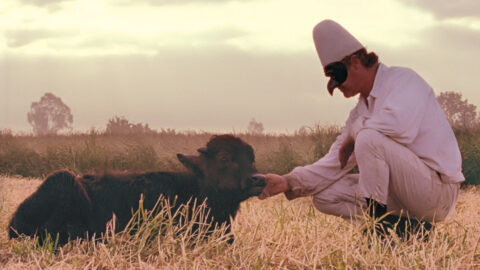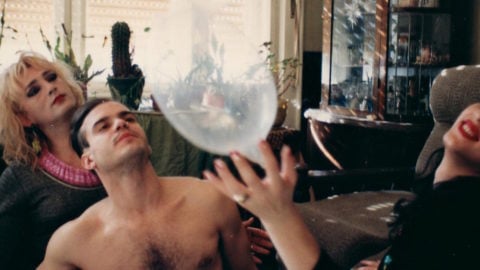Film of the Week: Lost and Beautiful
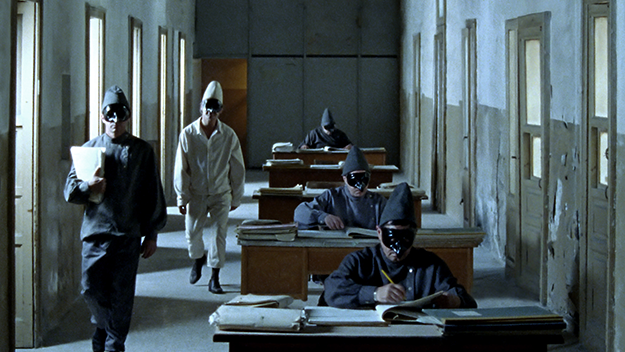
Pietro Marcello’s Lost and Beautiful is what you might call a UFO of a film—in this case, an Unidentified Folkloric Object. It’s partly a documentary, partly a poetic fantasy in which the characters include, as they are listed in an opening caption, “Sarchiapone: a Campanian buffalo; Tommaso: a Shepherd and guardian of an abandoned palace; Pulcinella: a traditional Campanian character, intermediary between the living and the dead.” The living and the dead mingle freely in a film that establishes a kind of dream-like intermediate realm, what you might call a “temporary autonomous zone,” between life and death, present and past, history and myth.
The film was originally planned as a documentary about Tommaso Cestrone, a shepherd in Caserta, in the Campania region of southern Italy. While maintaining his flock of sheep, Cestrone had been living and working as a volunteer guardian, looking after the abandoned palace of Carditello, an 18th-century residence of the Neapolitan Bourbon monarchy; the palace had long ago fallen to rack and ruin, and was subject to regular nocturnal looting by members of the Camorra, the local crime syndicate. Entirely self-funded, Cestrone, known locally as the “Angel of Carditello,” had vowed to see the palace restored to ownership by the nation—“I won’t leave here until it lives,” he declares at one point—although local judges constantly delayed signing the documents that would help bring the place back to life. While Marcello was making his film, Cestrone died of a heart attack, and the project became a different sort of tribute to him, and one significantly unlike any customary form of documentary.
The film begins with a roughly shot video section, apparently from the point of view of an animal—a speeded-up shot that pelts through the tiled corridors and stalls of some holding pen, with much thumping and crashing on the soundtrack, until the camera peers over a wall to show a buffalo calf lying in a stall. Then the action shifts to some bizarre netherworld where a group of black-masked, cap-wearing men in white are playing cards, communicating in wordless cackles, and tormenting another masked figure crouched behind chicken wire; another figure pretending to be a pregnant woman adds to the effect of a broad parody of rural life. These figures are all incarnations of Pulcinella, the stock clown character of Italian commedia dell’arte, who achieved worldwide currency in the more familiar form of Punch. The one Pulcinella the film follows is a stocky chap played by Sergio Vitolo, and we see him summoned by his masters—scribe figures dressed in green—to go on a mission among the mortals. A letter has arrived from Tommaso requesting that a buffalo named Sarchiapone be granted the gift of a voice so that he can tell his own life story, and Pulcinella is to accompany him.
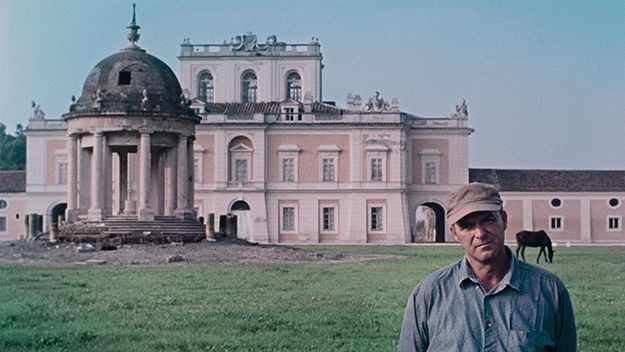
For much of the film, Sarchiapone does indeed tell his tale in voiceover (he’s voiced by high-profile actor Elio Germano), speaking in the tone of an 18th-century first-person novel, steeped in formal pathos: “My only roof was my mother’s womb.” The picaresque novel, recounting the comic peripatetic adventures of social outsiders or rogue figures, is the literary antecedent of the modern road movie, and a road movie is exactly what Lost and Beautiful becomes. Arriving among the mortals, Pulcinella collects Sarchiapone from the palace and accompanies him to another part of Italy—the region of Viterbo, further north—to hand him over to another shepherd, the real-life Gesuino Pittalis. The geographical factor provides the film with a sharp linguistic counterpoint, between the seemingly regular Italian that Pittalis speaks, and the gruff-voiced Pulcinella’s very broad delivery of the Campanian dialect.
Marcello is a director comfortable with hybrid form: his film The Mouth of the Wolf (09) was pitched between documentary and fictional re-enactment in its depiction of the relationship between a man in a Genoa prison and his transgender lover, catching a rough-hewn mood between Pasolini and Jean Genet. Lost and Beautiful is a fanciful patchwork, not least linguistically: it takes in two different languages, the matter-of-fact dialogue spoken between the imaginary Pulcinella and present-day real people (notably a couple of elderly farmers), Sarchiapone’s formal voice-off, a radio news broadcast announcing Cestrone’s death, and spoken poetry, including Gesuino’s recitation by a cave mouth of Gabriele d’Annunzio’s lyrical poem “The Shepherds” (a nice self-reflexive twist to have a real-life shepherd reciting a canonical poem that romantically mythifies his own trade). The formal mood of pastoral elegy is backed by a selection of classical music: Donizetti, Respighi, Scarlatti, 18th-century composer Antonio Casimir Cartellieri.
Marcello also assembles a patchwork of imagery: the bizarre, Brechtian prelude of massed Pulcinellas, the naturalistic sequences that Pulcinella incongruously leads the calf through, and then, hybrid scenes in which Pulcinella interacts with humans in scenes that evoke an antique world of pastoral myth. Before collecting the calf, Pulcinella stops to chat with two men netting birds by the roadside; they are entirely unsurprised to see him, and touch his hump for good luck. We also get a number of rough video-shot buffalo’s-eye-view sequences, 16mm footage, presumably archival footage, shown here, showing buffalo herding and buffalo baiting (something like a small-scale Italian equivalent to the notorious Pamplona bull run), and recent news footage of demonstrations in Campania, with placards showing the recent dead of all ages, notably many children (seemingly protests against the depredations of the Camorra).
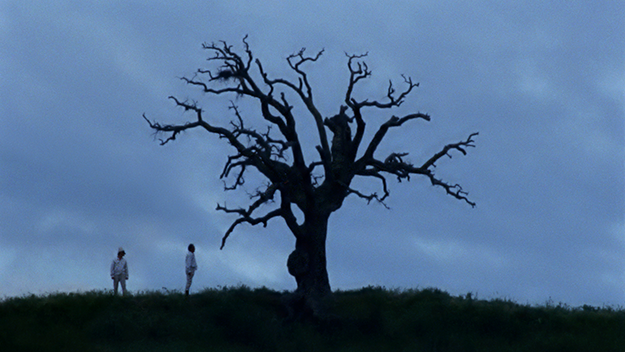
Lost and Beautiful might easily have come across as arcane or precious—and it does play sweet with a certain idea of 18th-century pastoral preciousness. Yet it’s a very tough film haunted by the sense of an end of things. The title is mysterious: the English inverts the original Bella e Perduta, which is feminine, and it’s hard not to assume that what’s lost is nothing less than Italia itself. That end of things, in one sense, is death, an inescapable part of rural life and the inexorable fate of agricultural livestock: as the hero of this tale, Sarchiapone is only in a state of reprieve from the fate that seemingly awaits him, which is to be eaten. Female buffalos are of use for their milk, to be turned into mozzarella, but males have limited use value: Cestrone first discovers Sarchiapone abandoned by the roadside, a fate that meets other male calves later on (we even glimpse skulls of some animals that weren’t lucky enough to be rescued). Rural Italy too, like farming communities worldwide, seems to be facing its own extinction, as we’re reminded when the elderly farmer tells Pulcinella that the local community is being slowly abandoned. “Angels” like Cestrone—able to reprieve beasts or palaces from seemingly inescapable doom—are few and far between.
While its documentary aspect reminds you of Raymond Depardon’s various films on French rural workers (including Modern Life, 08), Lost and Beautiful is also akin to other recent Italian films that consider the agricultural world as an increasingly precarious intermediate realm between nature and culture—Alice Rohrwacher’s The Wonders and Michelangelo Frammartino’s Le Quattro Volte. In its blending of fable and reality, it also has affinities with João Pedro Rodrigues’s bizarre recent excursion into gay Catholic picaresque, The Ornithologist, and with Eugène Green’s pastoral modern reworking of mediaeval quest narrative, The Living World. But Marcello’s is a much more overtly political film than any of those: a plea for awareness of and respect for local history and identity; a paean to the impassioned direct intervention of heroic activists like Cestrone; a reminder of the material realities that underlie the poetic myths of rural existence.
The film also muses on animal subjectivity, which is something other than the conventional anthropomorphism that Marcello uses ironically through his recourse to the literary trope of the ‘wise beast’. “In a world that denies we have a soul,” Sarchiapone comments, “being a buffalo is an art.” Marcello is unafraid to play with archaic forms of poetic pathos—as in the knowingly poignant close-up shot of the buffalo’s eye, one tear rolling from it. As a quasi-literary character, Sarchiapone might speak most eloquently, but the film constantly reminds us that he is, after all, just a buffalo: his most usual comment, in “conversation” with Pulcinella, is simply a basso moo, or “Bêêêêê…” (rhymes with “yeah”).
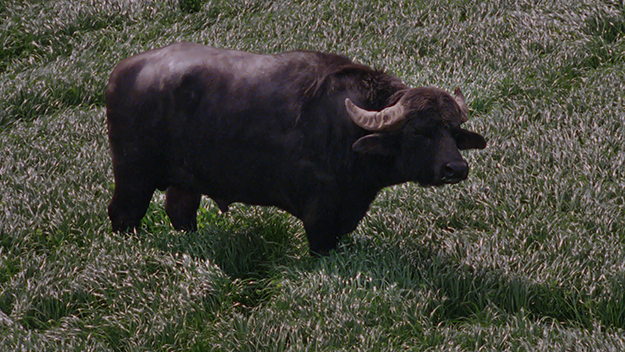
Perhaps the film’s most pointed image is of Gesuino burrowing underground into a hollow from which he excavates a few handfuls of crockery shards or other archeological fragments; it’s a literal image of the past existing under the surface of the present, and of the ways in which thriving cultures, like that of old agricultural Italy, get buried by historical change. “Dreams and fables, though imaginary, should tell the truth,” Sarchiapone comments at one point. It’s the curious virtue of this singularly original film that Lost and Beautiful manages to tell a truth that’s not just poetic, but political too, not just animal, but profoundly human.
Jonathan Romney is a contributing editor to Film Comment and writes its Film of the Week column. He is a member of the London Film Critics Circle.



